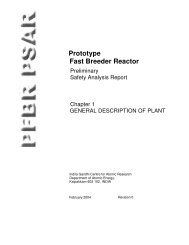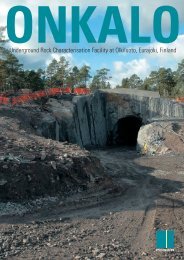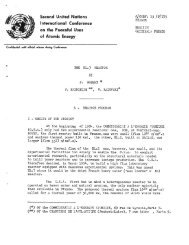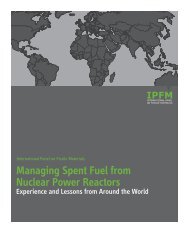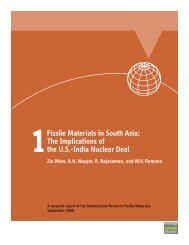Nuclear Proliferation TechnologyTrends Analysis - International ...
Nuclear Proliferation TechnologyTrends Analysis - International ...
Nuclear Proliferation TechnologyTrends Analysis - International ...
You also want an ePaper? Increase the reach of your titles
YUMPU automatically turns print PDFs into web optimized ePapers that Google loves.
PNNL -14480<br />
The bottom bearing must support the weight of the rotor, efficiently supply a<br />
“frictionless’ surface area, and have an extended lifetime. With a design lifetime of 10<br />
years, a high rotational speed (1200 rpm or more), and the small bearing size, it is an<br />
important and critical component.<br />
Table 6 lists important components used in centrifuge enrichment, and associated<br />
technical issues.<br />
3.2.2.2 Changes/improvements in technology<br />
Seven countries have successfully developed and utilized centrifuge technology over the<br />
last fifty years. Two primary approaches have been used, a great many relatively low<br />
enrichment sub-critical centrifuges or a lesser number of super-critical centrifuges that<br />
pass at least the first centrifuge critical speed. A variety of improvements and<br />
evolutionary changes have occurred in materials used, electronic speed control, bearing<br />
design, and internal improvements.<br />
1. Critical speeds<br />
Two basic approaches are taken to overcome the critical speed issue. The Soviets, the<br />
first to use centrifuge technology, selected the sub-critical approach. They used<br />
aluminum alloys and built machines about 50 cm tall and 50 mm in diameter. The<br />
original throughput was small, approximately 1 swu/yr or less. Accordingly, it took<br />
many thousands of centrifuges to meet production requirements.<br />
The second approach is to build ‘super-critical’ machines. Two approaches (sometimes<br />
combined) are taken here. In the first approach, flexible joints, called bellows, are built<br />
into the rotor, so it could bend freely with the dynamic forces and adopt new shapes as it<br />
accelerated through each critical speed. In the second approach, new materials, primarily<br />
carbon fiber, are used. These have a much higher tensile strength (almost twice that of<br />
aluminum alloys) and can spin at much higher speeds.<br />
2. Manufacturing processes<br />
Modern computer numerically-controlled machine tools in specially constructed "clean<br />
rooms” must be used. This ensures that the large quantity of high-precision parts needed<br />
to produce components for high-speed centrifuges are of sufficient quality to ensure longterm<br />
successful operation.<br />
16



